Linz (AT)
Les Dossiers synthétiques et d'enjeux sont disponibles gratuitement.
Merci de vous inscrire et vous connecter pour accéder au Dossier complet de site.
- Dossier synthétique EN
- Dossier d’enjeux EN
- Le site sur Google Maps
- Retour à la carte
Données synthétiques
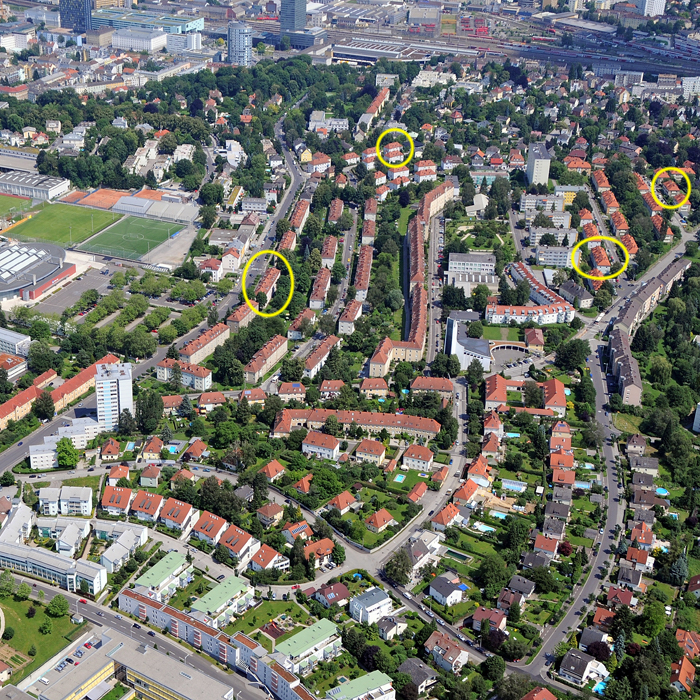
Linz (AT)
Scale L & XS urban and architectural and prototypes
Team representative urbanist & architect
Location Linz, Austria
Population 203,000 inhabitants
Strategic site 19.2 ha - Project site 4 prototypes
Site proposed by EBS
Actors involved EBS, City of Linz, OEBB
Owner(s) of the site EBS and OEBB
Commission after competition Further development and involvement in architectural project is intended
Information complémentaire
Urban City Strategy
Linz is an industrial city known for its steel production. During the Second World War arms were produced on a large scale, employing a lot of people. Housing production boomed with the garden city concept serving as a role model used paradigmatically throughout the city for entire quarters. The E16 site derives from that era, displaying a coherent ensemble within a lush green setting; its buildings mainly date back to 1938, mixed in are some later additions with higher density. Its unique position –five minutes away from the train station and in close proximity to the centre– lifts the site above the city due to its topography. An idyllic place to live, however, the building’s floor plans are outdated, and parking extensively consumes public space. The city is interested in a moderate densification, thereby enhancing connections to its wider surroundings and strengthening the nearby green network for pedestrians and bikes while ad- dressing concepts to foster mobility change.
Site Definition
The project site is characterised by a variety of building typologies. A heterogeneous urban ensemble distinguished by many existing potentials and resources, some of which need to be rediscovered and re-programmed in order to ensure a lasting, inclusive and diverse range of uses. In the centre of the neighbourhood there is a church, an elementary school and a park. The potential here has to be consi- dered in the transformation pro- cess. The E16 site unifies crucial questions on contemporary living within an existing urban fabric asking for the quality of space to be enhanced by re-densification. Seemingly a paradox, an answer to the question on how to expand from within will be at the core of resilient cities striving to co-exist with our planet.
How Must Metabolism and Inclusivity Be Developed and Connected?
How can an ensemble change in its conceptuality by working single objects? A prototypical approach is envisaged at this site, based on four exemplary building typologies. On the individual object, questions of accessibility, open space, mobility, programmatic flexibility, and climate issues have to be negotiated. How can a monofunctional housing area be converted into a diverse setting within its very programme of living? How can the culture of the everyday expand and network beyond its usual manner? What is the character of the site and what would be its contemporary interpretation? The potential of topography (views) and nature serve as a canvas for renegotiating density with spatial quality. By weaving the notion of sharing, layering and co-existing into a new spatial understanding, an inclusive context wants to be generated.
The interplay between scales, between the consideration of particular buildings at the project level and at the urban level, is to be used to further enhance the neighbourhood. A dialogue must be conducted between the overall urban scheme of the ensemble and the individual object. In which ways could the densification of existing structures be followed by a densification of (open) space qualities while integrating the current residents and already existing resources? The task is to achieve an agreeable level of density that ensures an inclusive, enduring diversity of uses through a mix of programmes, the opening up of shared spaces and the consideration of different living demands - not only conceived at the human level.
Working from the single unit is the key, thereby influencing and modifying the whole. Building a piece of the city on the very object, is essentially what we ask you to think about on this site.
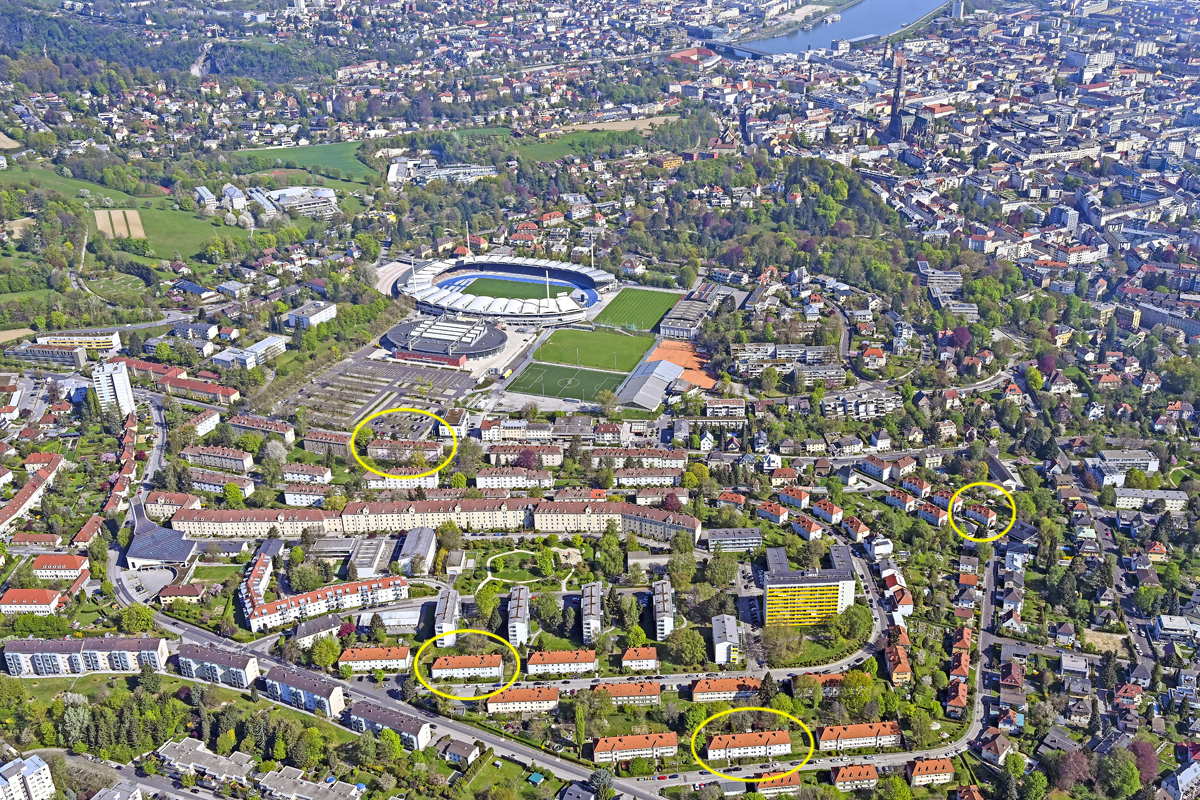
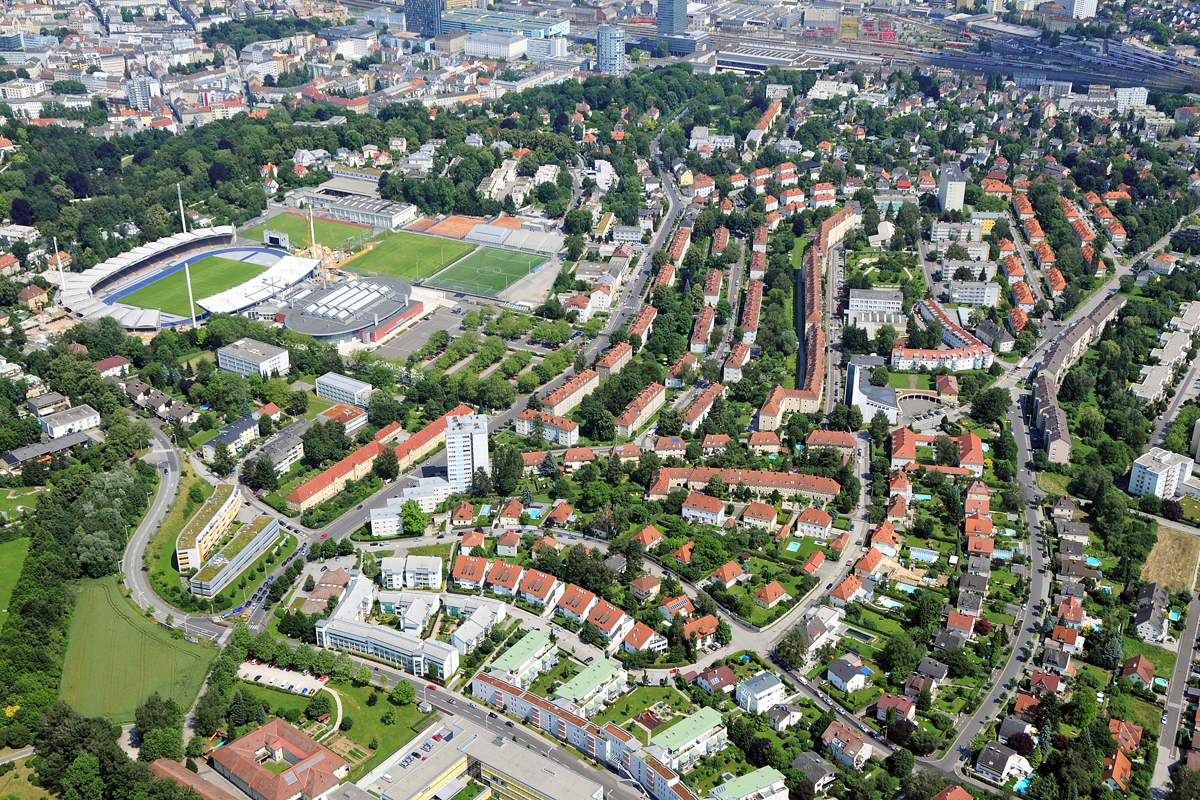
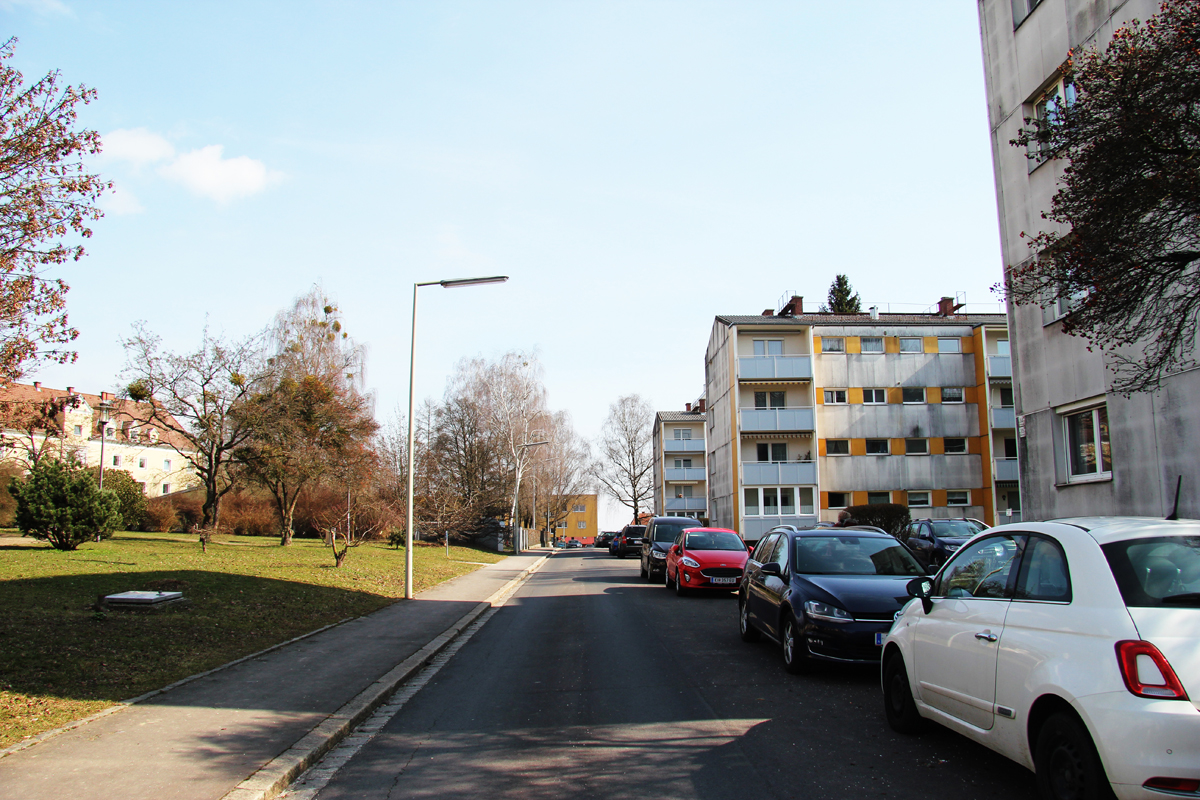
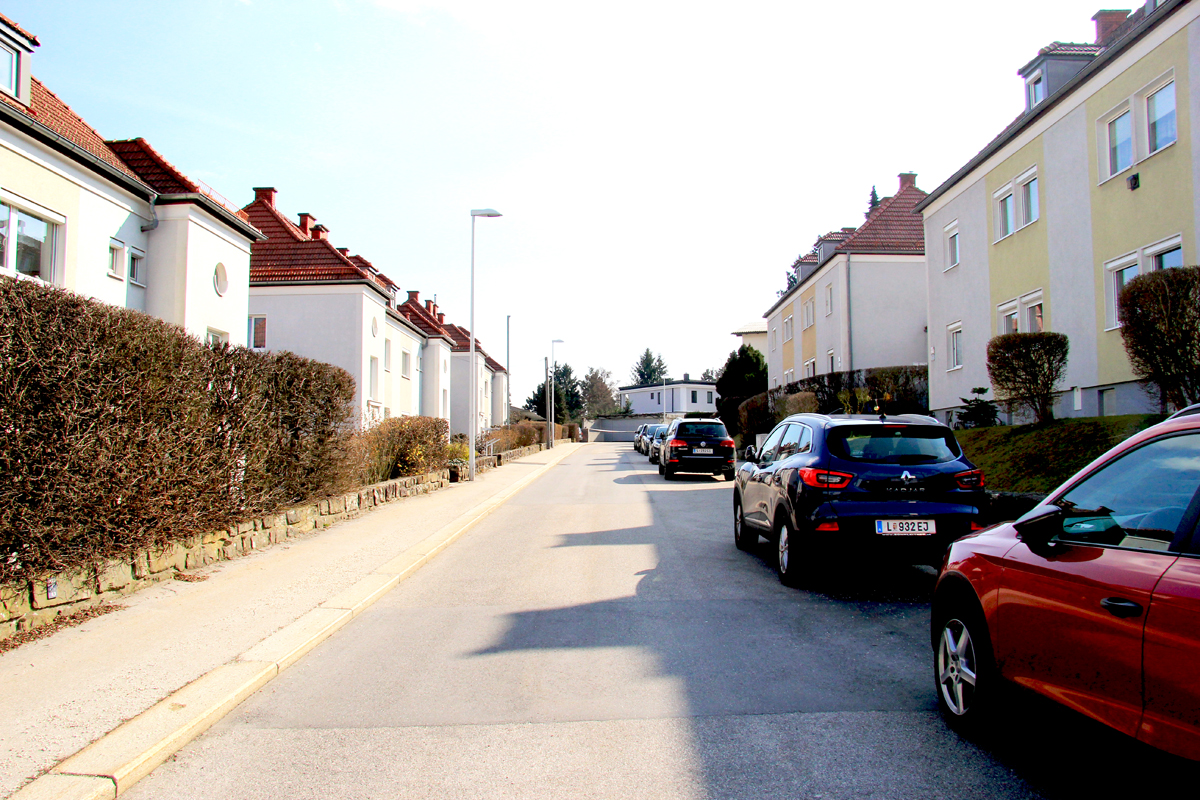
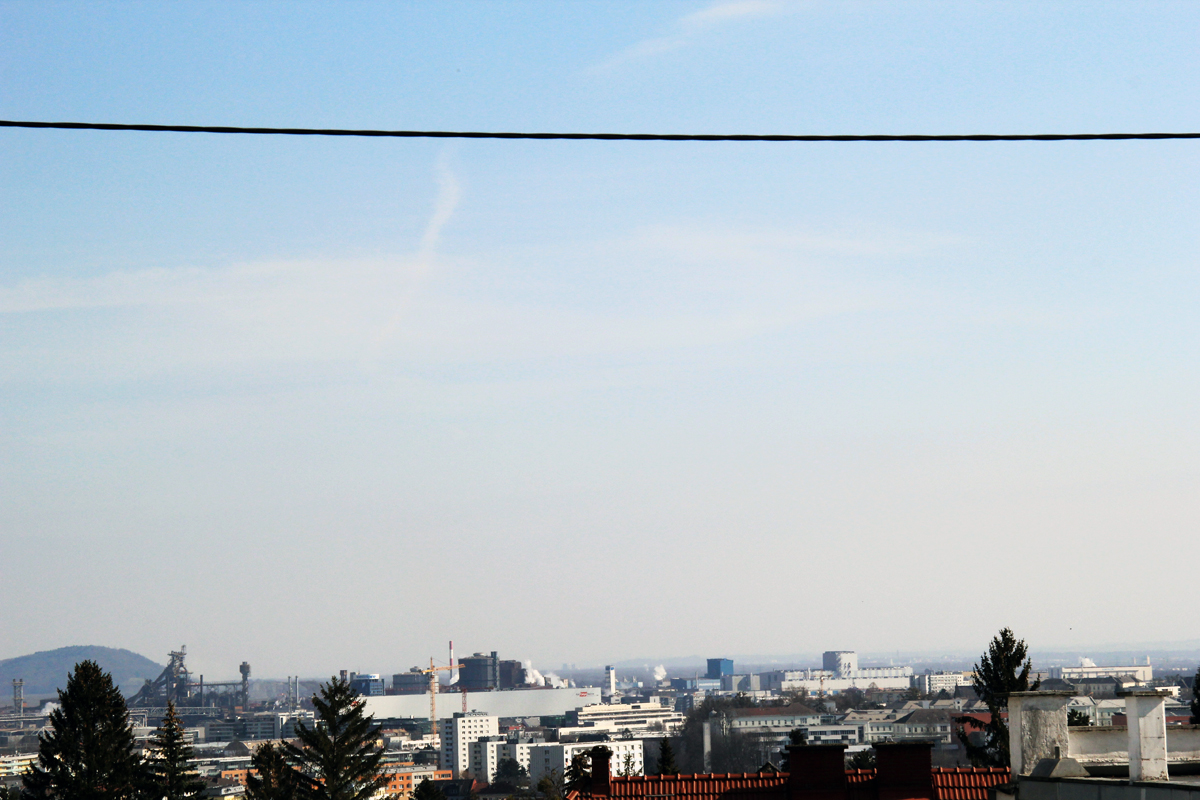
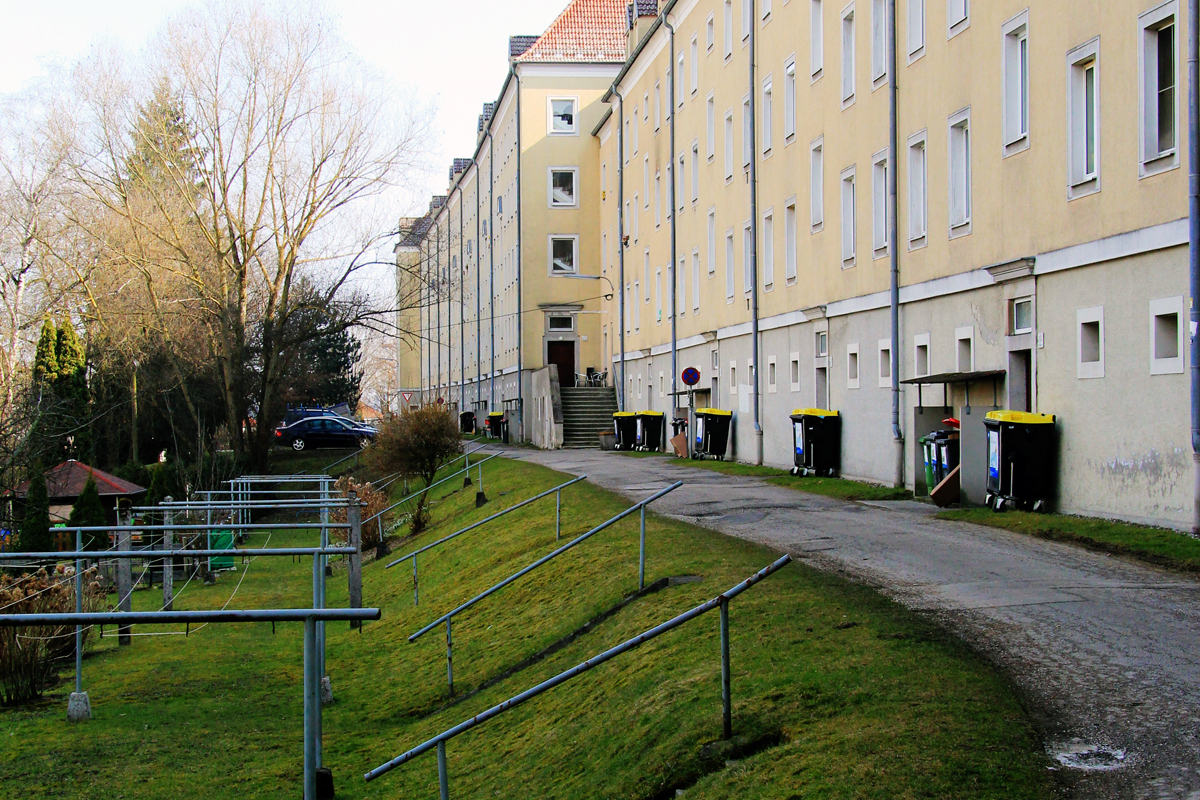
Questions à propos du site
1. What is the current usage of cellars and attics? Since their original function for washing, drying and coal storage is obsolete, how are these spaces used by residents now? Can we allocate this space for other uses and designate storage for bikes, garden equipment, etc. elsewhere?
The attic of prototype A contains one inhabited apartment of 45m2 each staircase. The attics of prototypes B, C and D are not developed yet. The cellar areas that are not in use (anymore) can be allocated for the above-mentioned functions and others more.
2. Would building additional floors on some buildings generate automatic requirements for elevators? What is the typical requirement for elevators in such buildings?
The aspect of barrier-free accessibility and usage should be addressed here in any case since most of the existing apartments are not barrier-free at the moment. We therefore recommend to orientate on the Upper Austrian Building Technology Act § 25 (3) that states, that in case of a new building as well as additions and alterations, that are equivalent to a new building, with more than three floors above ground level, at least one passenger elevator must be installed that provides access to all apartments.
3. Are any of the buildings under historic preservation that would limit form and roof alterations?
The individual buildings are not listed, but the city of Linz perceives the settlement in itself, worth preserving. Some parts, even buildings could be demolished. However, the current urban ensemble defines the character of the place and creates its very identity. The task here is to work with the underlying structure of the settlement and to improve it. On existing buildings, additions can be made - attached or on top. Also new built volumes in between are possible, all depending on your concept. To remove the whole settlement and come up with something completely different, is not envisaged by the owners nor the City of Linz. For the EUROPAN competition, no restrictions are set in terms of form and roof alterations.
4. Can we add accessory dwelling units, storage, or small communal structures in the semi-private backyards? Who owns and maintains the shared green space?
Additions to the shared areas are possible, but they should enhance or at least not reduce the quality of the open spaces. The open space between the buildings should be understood in its entirety with the landscape aspect contributing a crucial ingredient. We therefore strongly recommend a mixed team of planners. The spaces between the buildings (not the streets) are owned by ÖBB - the ground owner of the Strategic site. They are maintained by employees of EBS Wohnen Linz (building owner). The private spaces are maintained by the tenants themselves. At the moment, an internal system regulates the allocation and distribution of the private green spaces. When a tenant moves out, the new tenant is asked if he or she would like to take over the space. If this is not the case, it is returned to communal use.
5. Would additional units require designated off-street parking or can it be accommodated on-street?
The currently applicable Upper Austrian Building Technology Act §17(2) stipulates one car parking spot per newly constructed residential unit. However, this obligation can be partly deviated from in individual cases if suitable public transport is available for the users of the building for access and an alternative mobility concept is provided. In principle, the EUROPAN competition aims to reduce the number of cars parked on the street, since at the moment they strongly characterize the image of the settlement and severely limit the open space qualities for the residents. The existing, essentially very good public transport network, as well as concepts for sharing models, should lead to a reduction in individual car traffic in the future.
6. Does current flow of traffic in the area allow introduction of shared streets along the Dutch woonerf model?
Concepts that aim at a shared use of the streets as a mixed traffic area, which also leads to a reduction of individual car traffic and an improvement of the inhabitants' quality of stay in the open space, is very much in the interest of the EUROPAN competition. See also question number 5 and the ‘transport planning statement’-document in the download section (to be added on Monday 28th of June). Please note that those are recommendations, not binding requirements.
7. What is your prefer "flatmix" in residential buildings? Do you preferen living in small flats, or extra small flats for young people? Or do you prefer living for families in bigger flats in this area? Two-Three rooms and more....
The existing apartments within the prototypes in the settlement are rather small to medium-sized - they range from 45m2 (Type A, B), 60m2 (Type C), 70m2 (Type A) up to 80m2 (Type D). Since the resident structure of the Froschberg settlement is very diverse (in terms of age and household size), this diversity should also be reflected in the new floor plans. The floor plans of the existing apartments no longer meet today's living requirements. Ideas on forms of living that are able to accommodate changing needs, such as working from home, shift work, etc. and allow for a certain flexibility, are asked here.
8. Can we add community spaces? For example shared swimming pool? Shared workshop, shared fitness, community kindergarten? Is in this area any of them? Do you like idea of community shared spaces?
Shared spaces of various types and for various users are the focus of the EUROPAN 16 competition and should therefore be thought of in any case. In particular the use of the ground floor zones could be suitable for this matter. However, the main focus of the settlement should remain on housing. At the moment, the public facilities on the strategic site include a kindergarten, two elementary schools and a church (see Site Brief p. 15-16).
12. How much is it possible to intervene on existing buildings with additions and demolitions?
Finding the compatible/agreeable level of density for the site is the explicit goal of the competition. Almost anything is possible, from additions and conversions to expansion and subordinated demolition. Demolitions in larger extent that have a greater impact on the structure of the settlement should be well justified in any case but should not completely change the settlement’s underlying structure (see also answer number 3).
11. Are there any disused buildings in the area? if so, can they be reused? If there are any disused/abandoned buildings in the area that can be reused, is it possible to have them pinned on a map or a plan?
No, there are no disused buildings - neither on the project site nor on the strategic site.
10. Is there a city or neighborhood plan or rules on facade colors for buildings in the area?
The existing development plans of the city of Linz do not need to be taken into account, as they are already outdated. The majority of the existing plans is very strict and only depicts the existing buildings and thereby does not indicate any future developments. There are no specifications or rules regarding the colors of the facades of the buildings.
9. Are the green spaces between the buildings private? Is it possible to intervene in those areas?
There are different gradations of affiliation or responsibility of the green spaces. The gardens directly attached to a housing unit are mostly used and maintained by the residents themselves. The larger open spaces between the buildings are maintained by the employees of EBS Wohnen Linz - the building owners - and are owned by ÖBB. It is possible to intervene structurally in all of these areas, whereby the open space qualities should thereby be improved. See also the answer number 4.
17. Can you please upload more photographic documentation of all four types of buildings, close view exterior and interior (at least hallways and one apartment per each building)?
More images have been uploaded, see folder PS-b_ground-pictures:
AT-Linz-PS-P00a.pdf maps the location of the images.
Images AT-Linz-PS-P22 to AT-Linz-PS-P121 are new images showing the various typologies.
16. To which extent are we allowed to change existing buidlings - can we remove apex roofs, make holes on the facades, demolish some interior walls, build more floors?
There are no constraints regarding the modification of the existing buildings. With regard to the existing floor plans, the competition’s aim is to "update" them in order to accommodate today's diverse needs of the residents, such as accessibility and flexibility of use (see also answer number 2, 7, 12).
15. How many more residents living on the site do you expect in the future? Are there any specific numbers of the expected residential densification of the site?
The population development of the district Froschberg has continuously increased until 2017, since then a slight decrease can be observed, while the city of Linz registers the strongest population growth in Upper Austria. For the year 2040, 240,000 inhabitants - an increase of 15% - are predicted. The population decline of the district Froschberg is mainly due to internal migration - i.e. residents moving away to other city districts. However, it is to be expected that the population growth of the city of Linz will also be accompanied by an increase in the district of Froschberg. Also, the population density of the district of Froschberg is less than the density of comparable districts and can therefore be increased. The defined sustainable density identified within the EUROPAN competition can therefore influence how high the increase could and should turn out to be.
14. Is there a specific demographic mix expected to live on the site in the future - students, young couples, enterpreneurs, elderly? Or is this open for us to suggest?
While at the moment there are fewer 0-50-year-old residents in the Froschberg district compared to the Linz average, the number of 60+ residents is significantly higher than the city average and thus generally somewhat over-aged. The current residents are mostly ÖBB-employees and range from apprentices to executives. It is expected that the development of the settlement and the implementation of new buildings will lead to a rejuvenation of the residents, as Froschberg is already a desirable residential environment due to its central location. The specific vision of the composition of the future residents is open to you to suggest, but it is crucial that the diversity of the residents is also ensured in the future.
13. What kind of car parking is prefered - underground or above ground? Individual or collective?
See answer number 5 as well as the “transportation planning statement”-document by the City of Linz (AT-Linz-SS-M8-Transportation planning statement). This document provides information by the City of Linz but is not binding in the context of the EUROPAN competition. We ask for an overall concept for dealing with the current parking space problematic and the massive use of on-street parking spaces despite a very good connections to public transport. This should be thought of at the urban planning level rather than at the project level. For the future, it is desirable to reduce the heavily parked streets from the image of the settlement, which currently severely limit the quality of open space for residents.
18. The pdf 'AT-Linz-SS-M7.pdf’ mentions on page 5 that a ‘transport planning statement’ will be submitted later. Please distribute the respective data.
A statement regarding transportation planning is now available for download (AT-Linz-SS-M8-Transportation planning statement). Please note, that those are recommendations by the City of Linz and are not binding requirements for the EUROPAN competition. Supplementary information can also be found in answers 1, 5, 6 and 13.
19. The brief refers on page 24 to the Upper Austrian Building Technology Act, in particular to regulations regarding distances to other plots and streets. Are these binding for the proposal?
The reference to the Upper Austrian Building Technology Act §40 Distances to ground boundaries and traffic areas is intended to serve as an orientation of the "usual" distances, but is not to be regarded as binding for the design. However, if the distances radically fall below those of the Upper Austrian Building Technology Act §40, we recommend that a statement of reasons is given. This applies to distances within the planning area/strategic site. Upper Austrian Building Technology Act §40 must be complied with for adjacent properties outside the planning area.
20. The documents 'AT-Linz-PS-M5.pdf’ and 'AT-Linz-PS-M6.pdf’ display plans and legends containing building regulations regarding density (FAR) and boundaries (building lines). Are these binding for the proposal?
The specifications regarding the density (FAR) and the boundaries (building lines) on the documents are not binding, the development plans are outdated and do not have to be taken into account for the design proposals. We see EUROPAN as a way to develop an ideal and agreeable density for this area, which allows a respectful coexistence of all residents.
21. Which regulations regarding density, height and distances are binding for the proposal?
See answer number 2, 12, 19 and 20.
25. In the site visit document (page 1) is written that was going to be distributed an outcome of a survey done among the residents’ to acknowledge their preferences for future development. Since it is not available yet in the complete site folder, is there an estimated date to be uploaded?
We expect the outcome of the survey in the end of June/beginning of July. As soon as we receive the outcome, we will make it accessible for you.
22. How many inhabitants are currently living in Froschberg? Can you give an approximate breakdown about age ranges and about the current occupation rate of the neighborhood?
In the Froschberg district, 11,691 people currently live on an area of 452.8 ha. With a density of 25.8 persons per ha, the district is slightly above the Linz average (21.6). Residents aged 0-5 years: 4,8% (Linz average: 5,8%), 6-14 years: 7,0% (7,9%), 15-59 years: 59,5% (61,6%), 60+ years: 28,7% (24,8%). On the Strategic site itself, which lies within the district and extends over 19.2 ha, there are currently 56 buildings with 880 apartments with a gross floor area of 74,000m2. There is no precise data available on the exact number of residents living in the 880 apartments. There are currently no vacancies in the area, as the apartments are very sought after.
23. Regarding public transportation in the area: according to the document AT-Linz-SS-M7 (page 3) “a transport planning statement will be submitted later”. Is there an estimated date for this upload? Can you give a breakdown of the current usage of public transportation (tram/bus) by inhabitants?
A statement regarding transportation planning is now available for download (AT-Linz-SS-M8-Transportation planning statement). Please note, that those are recommendations by the City of Linz and are not binding requirements for the EUROPAN competition. Supplementary information can also be found in answers 1, 5, 6 and 13.
The public transportation system in this district is extremely well developed. Currently, there are six bus routes which connect this district. Two bus routes (26, 27) give the possibility to get direct access to the city centre. The bus 27 connects the industrial zone (chemical industry) to the Danube harbour of Linz. Four bus routes (17, 19, 45, 46) give the access to the traffic hub of the main railway station and main bus station of remote busses. The frequency is about 15 minutes and is increased up to approximately 7 minutes during rush hours. Due to topology of the district, a tramway cannot be established. In the mid-term future planning, no implementation of additional bus routes is considered.
There is no specific data available for the use of public transport within the district, but here you can find data on the number of users within the entire city of Linz, which shows that the number of people using buses has remained fairly constant over the last 10 years, while the number of registered cars has been steadily increasing.
24. Is the calculation of the density (in FAR terms, as explained on page 24 of the Brief document) a mandatory item for the submission? Should we plan according with the current legal framework of these local development plans (W111 and W111/5 at AT-Linz-PS-M7 or AT-Linz-PS-M8 or AT-Linz-SS-M5 as explained on page 3 AT-Linz-SS-M7)?
See answer number 20. The specifications regarding the density (FAR) on the documents are not binding. Please provide a calculation of the density as explained on page 24 of the Site Brief for each of the respective prototypes (project site). On the urban level (strategic site) rough suggestions for proposed densities are to be made, however the above-mentioned calculation method is not mandatory at this level.
26. To my opinion, a building was classified with a wrong typology in the documents. The building at “Hugo-Wolf-Straße 38” seems to be Type-B and not as stated in the documents Type-D. Could you please clarify.
26. Thank you for your question - It is actually the case that the marked building "Hugo-Wolf-Straße 38" is a hybrid between the two typologies. Hugo-Wolf-Straße 38 is only half-size of a full Type-B house: It has only one staircase with 3 apartments à 45m2 per floor. The building could therefore be described as a variant of type-B, which has one staircase instead of two (like type D).
Le site est lié au thème suivant
Reprise Une nouvelle énergie doit être trouvée pour ces sites à travers un traitement qui respecte l'environnement existant en introduisant des éléments et des actions spécifiques capables de développer une ville résiliente.
Intensifier les quartiers
Les sites de ce sous-groupe s'adressent à l'échelle d'un quartier plus vaste qui nécessite d'être requalifié et intensifié, ainsi que d'être enrichi de différentes qualités, telles que les usages, l'espace public, les éléments naturels, etc.
Documents spécifiques
Questions à propos du site
Pour pouvoir poser une question, vous devez être connecté (et, par conséquent, inscrit au concours).
Ve. 16 mai 2025
Date limite de soumission des questions
Ve. 30 mai 2025
Date limite de réponses aux questions
Avant de soumettre votre question, assurez-vous qu'elle n'apparaît pas déjà dans la FAQ.
Merci de poser vos questions sur les sites dans le menu Sites.
Merci de poser vos questions sur le règlement dans le menu Règlement.
Si votre question ne reçoit pas de réponse dans les 10 jours, merci de vérifier qu'elle ne figure pas dans la FAQ sous un autre intitulé ; sinon, contactez le secrétariat concerné par email (secrétariats nationaux pour les sites, secrétariat européen pour le règlement.)